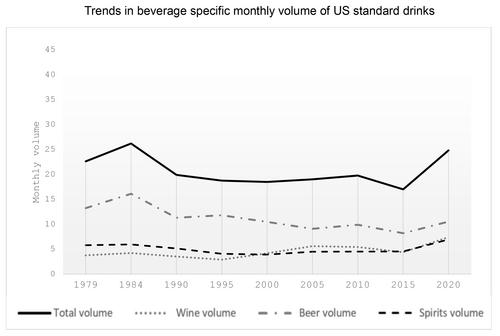Long-term trends in beverage-specific drinking in the National Alcohol Surveys: Differences by sex, age, and race and ethnicity
Abstract
Background
Despite substantial declines in underage drinking and binge drinking, alcohol consumption has increased in the past 30 years. This study examined how beverage-specific drinking patterns varied by sex, age, and race and ethnicity from 1979 to 2020.
Methods
Secondary data analysis was conducted on pooled data from the National Alcohol Survey series from 1979 to 2020 of a sample of U.S. adults ages 18 years or older. Total and beverage-specific volume were calculated from graduated frequency questions on reported beverage type, which included beer, wine, and spirits. Sex-stratified analyses focused on descriptive trends of each alcohol measure over time and by age and race and ethnicity. Time-varying effect models were also conducted to identify subgroups at higher risk for increased consumption over time.
Results
Women's drinking increased, with alcohol volume rising substantially from 2000 to 2020; the largest increase was among women 30 and older. Men's alcohol volume also rose over this period but remained below the levels of 1979 and 1984, with older adults increasing their consumption those 18–29 decreased their drinking. Beverage-specific trends showed some similarities by gender: in 2020, wine volume was at its highest level for both women and men, while spirits volume also was at its highest level for men and in women was tied with the 1979 peak in spirits consumption. Increases were also found among Black men and women and Latina women from 2000 to 2020.
Conclusions
Given the increases in alcohol volume, particularly among women and older age groups, alcohol policy, interventions, and education should consider ways to reduce harms associated with alcohol use among these groups. Continued monitoring of beverage-specific drinking patterns is needed to track policy-relevant changes.


 求助内容:
求助内容: 应助结果提醒方式:
应助结果提醒方式:


